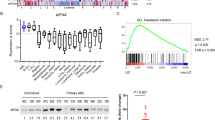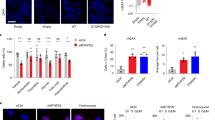Abstract
Translation initiation plays a critical role in cellular homeostasis, proliferation, differentiation and malignant transformation. Consistently, increasing the abundance of the eIF2–GTP–tRNAiMet translation initiation complex transforms normal cells and contributes to cancer initiation and the severity of some anemias. The chemical modifiers of the eIF2–GTP–tRNAiMet ternary complex are therefore invaluable tools for studying its role in the pathobiology of human disorders and for determining whether this complex can be pharmacologically targeted for therapeutic purposes. Using a cell-based assay, we identified N,N′-diarylureas as unique inhibitors of ternary complex accumulation. Direct functional-genetic and biochemical evidence demonstrated that the N,N′-diarylureas activate heme-regulated inhibitor kinase, thereby phosphorylating eIF2α and reducing the abundance of the ternary complex. Using tumor cell proliferation in vitro and tumor growth in vivo as paradigms, we demonstrate that N,N′-diarylureas are potent and specific tools for studying the role of eIF2–GTP–tRNAiMet ternary complex in the pathobiology of human disorders.
This is a preview of subscription content, access via your institution
Access options
Subscribe to this journal
Receive 12 print issues and online access
$259.00 per year
only $21.58 per issue
Buy this article
- Purchase on Springer Link
- Instant access to full article PDF
Prices may be subject to local taxes which are calculated during checkout





Similar content being viewed by others
References
Marshall, L., Kenneth, N.S. & White, R.J. Elevated tRNA(iMet) synthesis can drive cell proliferation and oncogenic transformation. Cell 133, 78–89 (2008).
Ranganathan, A.C., Ojha, S., Kourtidis, A., Conklin, D.S. & Aguirre-Ghiso, J.A. Dual function of pancreatic endoplasmic reticulum kinase in tumor cell growth arrest and survival. Cancer Res. 68, 3260–3268 (2008).
Harding, H.P. et al. Ppp1r15 gene knockout reveals an essential role for translation initiation factor 2 alpha (eIF2alpha) dephosphorylation in mammalian development. Proc. Natl. Acad. Sci. USA 106, 1832–1837 (2009).
Heaney, J.D., Michelson, M.V., Youngren, K.K., Lam, M.Y. & Nadeau, J.H. Deletion of eIF2beta suppresses testicular cancer incidence and causes recessive lethality in agouti-yellow mice. Hum. Mol. Genet. 18, 1395–1404 (2009).
Skalnikova, H. et al. Protein signaling pathways in differentiation of neural stem cells. Proteomics 8, 4547–4559 (2008).
Asano, K., Clayton, J., Shalev, A. & Hinnebusch, A.G. A multifactor complex of eukaryotic initiation factors, eIF1, eIF2, eIF3, eIF5, and initiator tRNA(Met) is an important translation initiation intermediate in vivo. Genes Dev. 14, 2534–2546 (2000).
Algire, M.A., Maag, D. & Lorsch, J.R. Pi release from eIF2, not GTP hydrolysis, is the step controlled by start-site selection during eukaryotic translation initiation. Mol. Cell 20, 251–262 (2005).
Prostko, C.R., Dholakia, J.N., Brostrom, M.A. & Brostrom, C.O. Activation of the double-stranded RNA-regulated protein kinase by depletion of endoplasmic reticular calcium stores. J. Biol. Chem. 270, 6211–6215 (1995).
Srivastava, S.P., Davies, M.V. & Kaufman, R.J. Calcium depletion from the endoplasmic reticulum activates the double-stranded RNA-dependent protein kinase (PKR) to inhibit protein synthesis. J. Biol. Chem. 270, 16619–16624 (1995).
Aktas, H. et al. Depletion of intracellular Ca2+ stores, phosphorylation of eIF2alpha, and sustained inhibition of translation initiation mediate the anticancer effects of clotrimazole. Proc. Natl. Acad. Sci. USA 95, 8280–8285 (1998).
Donzé, O., Jagus, R., Koromilas, A.E., Hershey, J.W. & Sonenberg, N. Abrogation of translation initiation factor eIF-2 phosphorylation causes malignant transformation of NIH 3T3 cells. EMBO J. 14, 3828–3834 (1995).
Rosenwald, I.B., Hutzler, M.J., Wang, S., Savas, L. & Fraire, A.E. Expression of eukaryotic translation initiation factors 4E and 2alpha is increased frequently in bronchioloalveolar but not in squamous cell carcinomas of the lung. Cancer 92, 2164–2171 (2001).
Abraham, N. et al. The murine PKR tumor suppressor gene is rearranged in a lymphocytic leukemia. Exp. Cell Res. 244, 394–404 (1998).
Rosenwald, I.B. et al. Expression of the translation initiation factors eIF-4E and eIF-2* is frequently increased in neoplastic cells of Hodgkin lymphoma. Hum. Pathol. 39, 910–916 (2008).
Rosenwald, I.B., Wang, S., Savas, L., Woda, B. & Pullman, J. Expression of translation initiation factor eIF-2alpha is increased in benign and malignant melanocytic and colonic epithelial neoplasms. Cancer 98, 1080–1088 (2003).
Wek, R.C., Jiang, H.Y. & Anthony, T.G. Coping with stress: eIF2 kinases and translational control. Biochem. Soc. Trans. 34, 7–11 (2006).
Chen, J.J. Regulation of protein synthesis by the heme-regulated eIF2alpha kinase: relevance to anemias. Blood 109, 2693–2699 (2007).
Chen, J.J. Heme-regulated elF-2a kinase. in Translational Control of Gene Expression (eds. Sonenberg, N. et al.) 529–546 (Cold Spring Harbor Laboratory Press, New York, 2000).
Han, A.P., Fleming, M.D. & Chen, J.J. Heme-regulated eIF2alpha kinase modifies the phenotypic severity of murine models of erythropoietic protoporphyria and beta-thalassemia. J. Clin. Invest. 115, 1562–1570 (2005).
Harding, H.P., Zhang, Y., Bertolotti, A., Zeng, H. & Ron, D. Perk is essential for translational regulation and cell survival during the unfolded protein response. Mol. Cell 5, 897–904 (2000).
Marbach, I., Licht, R., Frohnmeyer, H. & Engelberg, D. Gcn2 mediates Gcn4 activation in response to glucose stimulation or UV radiation not via GCN4 translation. J. Biol. Chem. 276, 16944–16951 (2001).
Su, Q. et al. Modulation of the eukaryotic initiation factor 2 alpha-subunit kinase PERK by tyrosine phosphorylation. J. Biol. Chem. 283, 469–475 (2008).
Biason-Lauber, A., Lang-Muritano, M., Vaccaro, T. & Schoenle, E.J. Loss of kinase activity in a patient with Wolcott-Rallison syndrome caused by a novel mutation in the EIF2AK3 gene. Diabetes 51, 2301–2305 (2002).
Harding, H.P. et al. Regulated translation initiation controls stress-induced gene expression in mammalian cells. Mol. Cell 6, 1099–1108 (2000).
Lu, P.D., Harding, H.P. & Ron, D. Translation reinitiation at alternative open reading frames regulates gene expression in an integrated stress response. J. Cell Biol. 167, 27–33 (2004).
Vattem, K.M. & Wek, R.C. Reinitiation involving upstream ORFs regulates ATF4 mRNA translation in mammalian cells. Proc. Natl. Acad. Sci. USA 101, 11269–11274 (2004).
Ziegeler, G. et al. Embryonic lethal abnormal vision-like HuR-dependent mRNA stability regulates post-transcriptional expression of cyclin-dependent kinase inhibitor p27Kip1. J. Biol. Chem. 285, 15408–15419 (2010).
Brewer, J.W. & Diehl, J.A. PERK mediates cell-cycle exit during the mammalian unfolded protein response. Proc. Natl. Acad. Sci. USA 97, 12625–12630 (2000).
Lomenick, B. et al. Target identification using drug affinity responsive target stability (DARTS). Proc. Natl. Acad. Sci. USA 106, 21984–21989 (2009).
Moerke, N.J. et al. Small-molecule inhibition of the interaction between the translation initiation factors eIF4E and eIF4G. Cell 128, 257–267 (2007).
Lu, L., Han, A.P. & Chen, J.J. Translation initiation control by heme-regulated eukaryotic initiation factor 2alpha kinase in erythroid cells under cytoplasmic stresses. Mol. Cell. Biol. 21, 7971–7980 (2001).
Scheuner, D. et al. Translational control is required for the unfolded protein response and in vivo glucose homeostasis. Mol. Cell 7, 1165–1176 (2001).
Dever, T.E. Gene-specific regulation by general translation factors. Cell 108, 545–556 (2002).
Koromilas, A.E. et al. The interferon-inducible protein kinase PKR modulates the transcriptional activation of immunoglobulin kappa gene. J. Biol. Chem. 270, 25426–25434 (1995).
Boyce, M. et al. A pharmacoproteomic approach implicates eukaryotic elongation factor 2 kinase in ER stress-induced cell death. Cell Death Differ. 15, 589–599 (2008).
Boyce, M. et al. A selective inhibitor of eIF2alpha dephosphorylation protects cells from ER stress. Science 307, 935–939 (2005).
Harding, H.P. et al. Diabetes mellitus and exocrine pancreatic dysfunction in perk−/− mice reveals a role for translational control in secretory cell survival. Mol. Cell 7, 1153–1163 (2001).
Araki, E., Oyadomari, S. & Mori, M. Impact of endoplasmic reticulum stress pathway on pancreatic beta-cells and diabetes mellitus. Exp. Biol. Med. (Maywood) 228, 1213–1217 (2003).
Katayama, T. et al. Presenilin-1 mutations downregulate the signalling pathway of the unfolded-protein response. Nat. Cell Biol. 1, 479–485 (1999).
Xu, C., Bailly-Maitre, B. & Reed, J.C. Endoplasmic reticulum stress: cell life and death decisions. J. Clin. Invest. 115, 2656–2664 (2005).
Palakurthi, S.S., Aktas, H., Grubissich, L.M., Mortensen, R.M. & Halperin, J.A. Anticancer effects of thiazolidinediones are independent of peroxisome proliferator-activated receptor gamma and mediated by inhibition of translation initiation. Cancer Res. 61, 6213–6218 (2001).
Aktas, H., Cai, H. & Cooper, G.M. Ras links growth factor signaling to the cell cycle machinery via regulation of cyclin D1 and the Cdk inhibitor p27KIP1. Mol. Cell. Biol. 17, 3850–3857 (1997).
Acknowledgements
We thank D.C. Tosteson (Harvard Medical School), mentor and role model to authors, for encouragement; J.J. Chen for providing the HRI expression plasmid; and M. Tosteson for critical comments on the manuscript. This work was supported in part by NIH grant NCDDG 5 U19 CA87427 to J.A.H., Susan B. Komen Foundation for Cancer Research grant BCTR0707713, US Department of Defense grant no. W81ZWH-05-1-0096 and US National Institutes of Health grant no. R21AG032546 to B.H.A.
Author information
Authors and Affiliations
Contributions
T.C. characterized hits compounds, carried out experiments to determine the mechanism of action of hit compounds, analyzed the data and contributed to writing the paper; D.O. generated the screening assay and helped initial compound characterization; Y.Q. generated and characterized PC-3 cell lines; F.H. carried out screening campaign; L.C. carried out cell growth experiments; S.D. carried out small scale resynthesis of compounds; X.H., N.Z. and J.G.S. developed and validated an LC-MS method and analyzed mouse plasma samples; M.C. supervised synthesis and contributed to writing the paper; J.A.H. discussed the data and contributed to writing the manuscript; B.H.A. conceived, designed and supervised all aspects of research, analyzed the data and wrote the manuscript.
Corresponding author
Ethics declarations
Competing interests
The authors declare no competing financial interests.
Supplementary information
Supplementary Text and Figures
Supplementary Methods and Supplementary Results (PDF 2473 kb)
Supplementary Dataset 1
Confirmation of initial hits with the ternary complex assay. Initial hits were confirmed in the ternary complex assay by testing in triplicate at 10 and 5 or 2.5 μM concentrations. Chemical structures can be obtained by entering the NSC number at http://dtp.nci.nih.gov/dtpstandard/ChemData/index.jsp. (XLS 78 kb)
Rights and permissions
About this article
Cite this article
Chen, T., Ozel, D., Qiao, Y. et al. Chemical genetics identify eIF2α kinase heme-regulated inhibitor as an anticancer target. Nat Chem Biol 7, 610–616 (2011). https://doi.org/10.1038/nchembio.613
Received:
Accepted:
Published:
Issue Date:
DOI: https://doi.org/10.1038/nchembio.613
This article is cited by
-
Targeting the integrated stress response in hematologic malignancies
Experimental Hematology & Oncology (2022)
-
Heme-regulated inhibitor: an overlooked eIF2α kinase in cancer investigations
Medical Oncology (2022)
-
Eukaryotic translation initiation factors as promising targets in cancer therapy
Cell Communication and Signaling (2020)
-
A multi-omics analysis reveals the unfolded protein response regulon and stress-induced resistance to folate-based antimetabolites
Nature Communications (2020)
-
Adult mouse eIF2Bε Arg191His astrocytes display a normal integrated stress response in vitro
Scientific Reports (2018)



